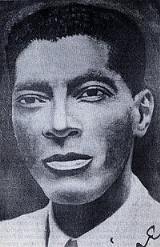
Manuel Corona
Encyclopedia
Manuel Corona Raimundo was a Cuban trova
musician, and a long-term professional rival of Sindo Garay
.
 He came to Havana when the Cuban War of Independence
He came to Havana when the Cuban War of Independence
broke out, and worked as a bootblack and a cigar-roller. His supervisor at the cigar factory taught him the guitar, and in 1905 he set up in a café in the red-light district of San Isidro. The district was controlled by the chulo (pimp) Alberto Yarini (1882–1910), who became famous for introducing French prostitutes (putas francesas) willing to perform more salacious acts than even the Cubans were used to. The francesas cut heavily into the profits of the Cuban putas, and the result was a gang war in which Yarini was killed.
Corona was present through all this, playing and singing to the punters, whores and pimps. He and one of the girls developed a love affair, and soon enough her pimp was on his trail. In a line that might have come from Frankie and Johnny
, Corona said later "She was a whore, and she had her man, but I liked her." The pimp came after him with a knife, and a cut to his hand prevented him playing the guitar again. From then on he lived from his compositions.
He wrote hundreds of compositions, some of them amongst the finest examples of Cuban sentiment, such as Mercedes, Longina, Santa Cecilia and Aurora. Guarachas such as El servicio obligatorio (National Service) and Acelera, Ñico, acelera were topical comments. La habanera was a deliberate reply to Garay's La bayamesa. Corona died in poverty.
Trova
Trova is one of the great roots of the Cuban music tree. In the 19th century a group of itinerant musicians known as trovadores moved around Oriente, especially Santiago de Cuba, earning their living by singing and playing the guitar...
musician, and a long-term professional rival of Sindo Garay
Sindo Garay
Sindo Garay was born Antonio Gumersindo Garay Garcia . He was the first, the smallest, and perhaps the longest-lived, of the trova artists taught by Pepe Sánchez. Garay was one of the four greats of the trova. Sindo Garay was Spanish & Arawkan descendant...
.

Cuban War of Independence
Cuban War of Independence was the last of three liberation wars that Cuba fought against Spain, the other two being the Ten Years' War and the Little War...
broke out, and worked as a bootblack and a cigar-roller. His supervisor at the cigar factory taught him the guitar, and in 1905 he set up in a café in the red-light district of San Isidro. The district was controlled by the chulo (pimp) Alberto Yarini (1882–1910), who became famous for introducing French prostitutes (putas francesas) willing to perform more salacious acts than even the Cubans were used to. The francesas cut heavily into the profits of the Cuban putas, and the result was a gang war in which Yarini was killed.
Corona was present through all this, playing and singing to the punters, whores and pimps. He and one of the girls developed a love affair, and soon enough her pimp was on his trail. In a line that might have come from Frankie and Johnny
Frankie and Johnny
-Films:*Frankie and Johnny , 1936 film co-starring Lilyan Tashman*Frankie and Johnny , a film starring Elvis Presley*Frankie and Johnny , a 1991 film based on McNally's play-Other:...
, Corona said later "She was a whore, and she had her man, but I liked her." The pimp came after him with a knife, and a cut to his hand prevented him playing the guitar again. From then on he lived from his compositions.
He wrote hundreds of compositions, some of them amongst the finest examples of Cuban sentiment, such as Mercedes, Longina, Santa Cecilia and Aurora. Guarachas such as El servicio obligatorio (National Service) and Acelera, Ñico, acelera were topical comments. La habanera was a deliberate reply to Garay's La bayamesa. Corona died in poverty.

